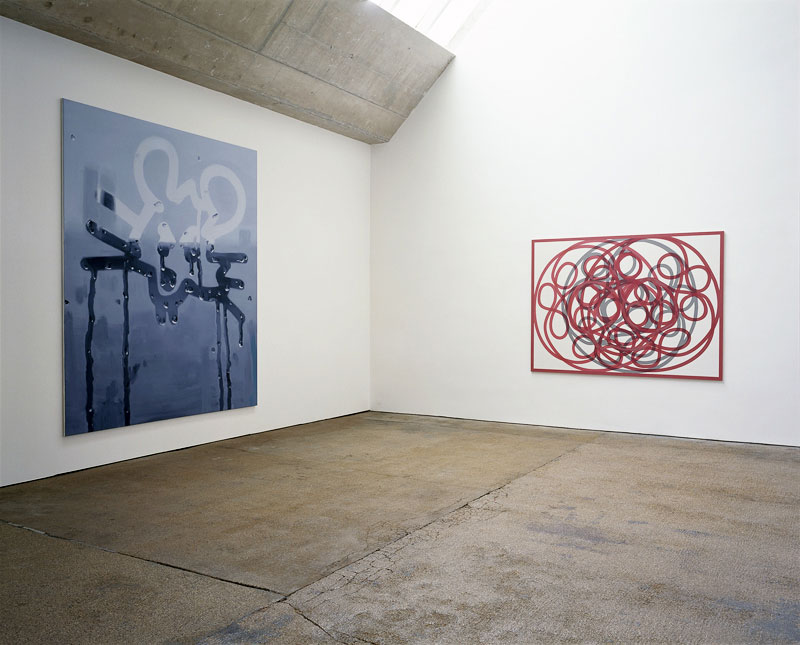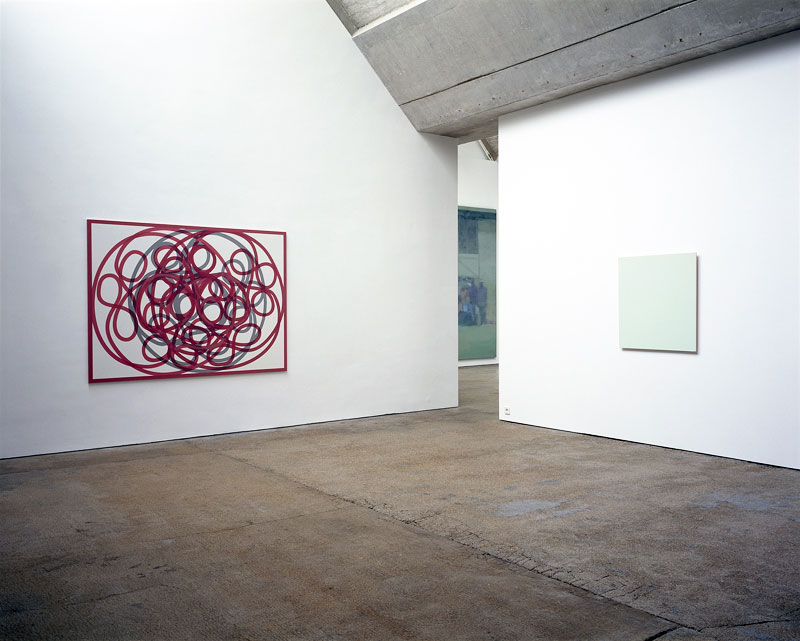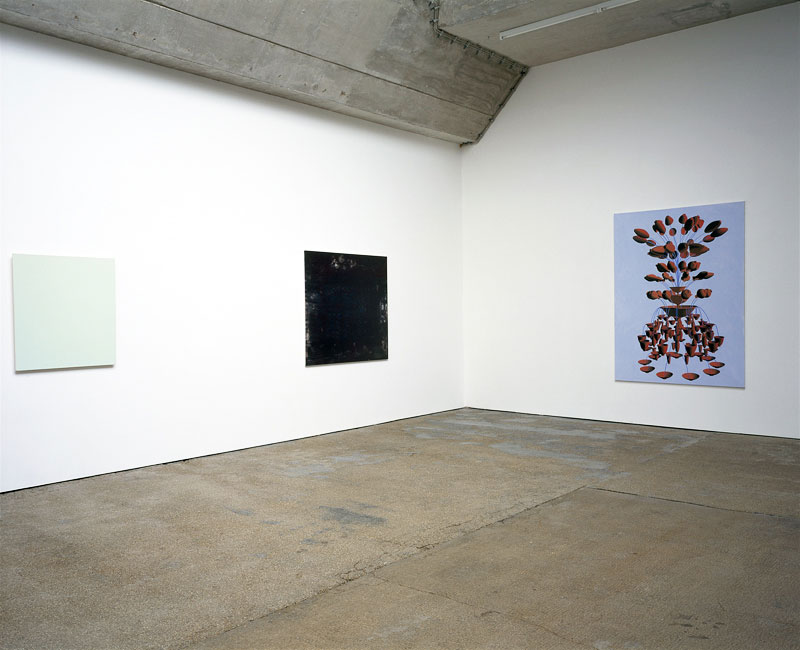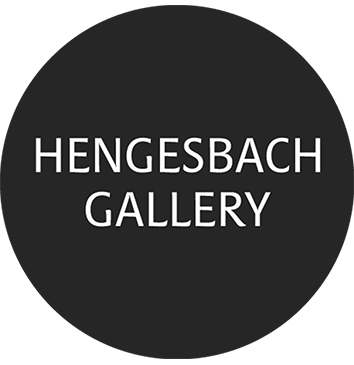Ola Billgren, Mihai Grecu & Thibault Gleize, Thomas Huber, Joseph Marioni, Walter Obholzer and Markus Willeke
27 April – 22 June 2013
Smoking pastries and misty windowpanes. Glowing surfaces and cool gestures. Five paintings and one video. The group exhibition BILDFROST (frozenness) presents a selection of figurative and abstract works that explore how cold and hot an image can be. A showcase of emphatic inwardness and pointed actions featuring artists Ola Billgren, Mihai Grecu & Thibault Gleize, Thomas Huber, Joseph Marioni, Walter Obholzer, and Markus Willeke, on view from April 27 to June 22, 2013, at Hengesbach Gallery.
Ola Billgren’s For the Night II (1997) shows bluish dark hues, with traces of white. The image initially resists interpretation. A restless oscillation emanates from the center, directing expectation toward a landscape space fading into darkness. At the same time, it becomes apparent that the color fabric stems from a painterly grid structure. Is coarse-pixel photography being translated into painting here, or is painting imitating a print? Understanding the romantic appearance remains an act of will. The work resists external demands for comprehension and calls for an active stance from the viewer. A motif caught between figurative address and media reflection.
The title of Mihai Grecu and Thibault Gleize’s work Glucose (2012) refers to a carbohydrate that normally exists in solid form, is highly water-soluble, and begins to melt at 146 degrees Celsius. This material mutability is reflected in a fish swimming in air defying physical laws, in chocolates seemingly dissolving into gas, and in a fried egg that in close-up morphs into a shimmering corona. Rigid surfaces ripple with flowing waves. Further contrast is provided by abstract shots of an icy wall—perhaps a mountain, perhaps just a surface. In Glucose, proportions and laws of nature are dissolved in favor of a self-contained associative world. These interventions are disturbing because they break with the dichotomies of perception: where there is air, there is no water; and where there is no water, a fish cannot swim. At the same time, these ruptures have a liberating effect. Breaking fundamental constants carries not just a destructive impulse but also an ironic commentary: the creation of an illogical alternative to known opposites.
Thomas Huber’s Fountain Test (2004) is a model of disciplined painting: the light-shadow relationships appear meticulously calibrated, the resulting contrasts follow with millimeter precision. Red carafes and the blue water streams flowing from them are arranged so that even a centimeter’s deviation would seem to threaten the compositional order. Immersed in the architecture of the work, one might overlook the absence of any practical function. The composition recalls the ritual of collecting water. The carafes, set against a light blue background, hover in emptiness, suspended in the image. The water flows in fountains, both downward and upward, yet without human intervention and without the carafes filling. On one hand, one wants to be the agent of this juggling act with its bubbling possibilities; at the same time, a consciousness arises that the abundance of possibilities offers nothing concrete, so that our own inadequacy stumbles upon them. A similar kind of experiential quality is found in Joseph Marioni’s White Painting (2003). The glaze-like layers of paint reveal their structure along the side edges and bottom of the canvas, encouraging an object-focused interpretation of the work. As if the paint had draped itself over the canvas like a coat, Marioni’s paintings emphasize the shoulders with a wider span, the lower hem with an open seam, and the sides with overlapping taperings.
The fine weave of the canvas shows through the paint. Like human skin, the canvas seems to sense the tactile quality of the color in each of its individual cells. The hue of the painting resembles a coat: to face the world, it protects against cold and wet, while also retaining inner warmth. The tone reveals something of the affective atmosphere in which the world meets us and with which we absorb it into ourselves.
In Walter Obholzer’s work Rosettes (2000), larger and smaller line patterns intertwine. They have sharply contoured edges and are roughly equal in width. The red formation seems to double itself in a twisted reflection and condenses toward the center into unresolvable paths. Meanwhile, behind the red formation, one’s own shadow looms. There appears to be no clear image center, but rather a system—one that remains elusive. Do these forms strive to become ornaments, or do the paths clash in a kind of interplay of displacement and contact?
The painting does not reveal itself. No brushstrokes are visible. The paint appears soft, the substrate and contours hard, the hue muted, the mood cool—despite the red.
A rat on a fogged-up window. Its face is the result of a fleeting finger drawing: eyes and nose quickly dabbed onto the glass, whiskers drawn in, a smile hinted at. That such a spontaneous finger sketch can survive in large-scale painterly format is the first surprise in Markus Willeke’s paintings. His Rat (2013), created in a powerfully dynamic style, peers just as slyly from the canvas as it would from a car window or a child’s room. The casual outcome of a hand movement is not only preserved here but elevated to the monumental.
What’s distinctive is that one keeps looking and retains the impression that Willeke’s paintings have just come into being—immediate, fast. Even when one knows every drop and waits for the moisture to evaporate and the rat to disappear, the image retains its element of surprise. It renders transience visible and translates it through painting into a visual permanence. At the same time, the painting circles around its own enigma. It deals with three-dimensional reality within a two-dimensional format. Willeke works with membrane-like motifs that raise questions about what lies behind and in front. Are we enduring or fleeting? Is the surface a boundary or an opening to something else?
BILDFROST (frozenness) thus reveals dichotomies that are broken, and vistas that expand into panoramas. Smoking pastries and misty windowpanes. Glowing surfaces and cool gestures. Five paintings and one video present how close cold can be to warmth—and how inhibited or unrestrained the perceptions linked to them can become. Simultaneously with this exhibition, Hengesbach Gallery is presenting new works by Dirk Eicken under the title in between.
Installation Views



